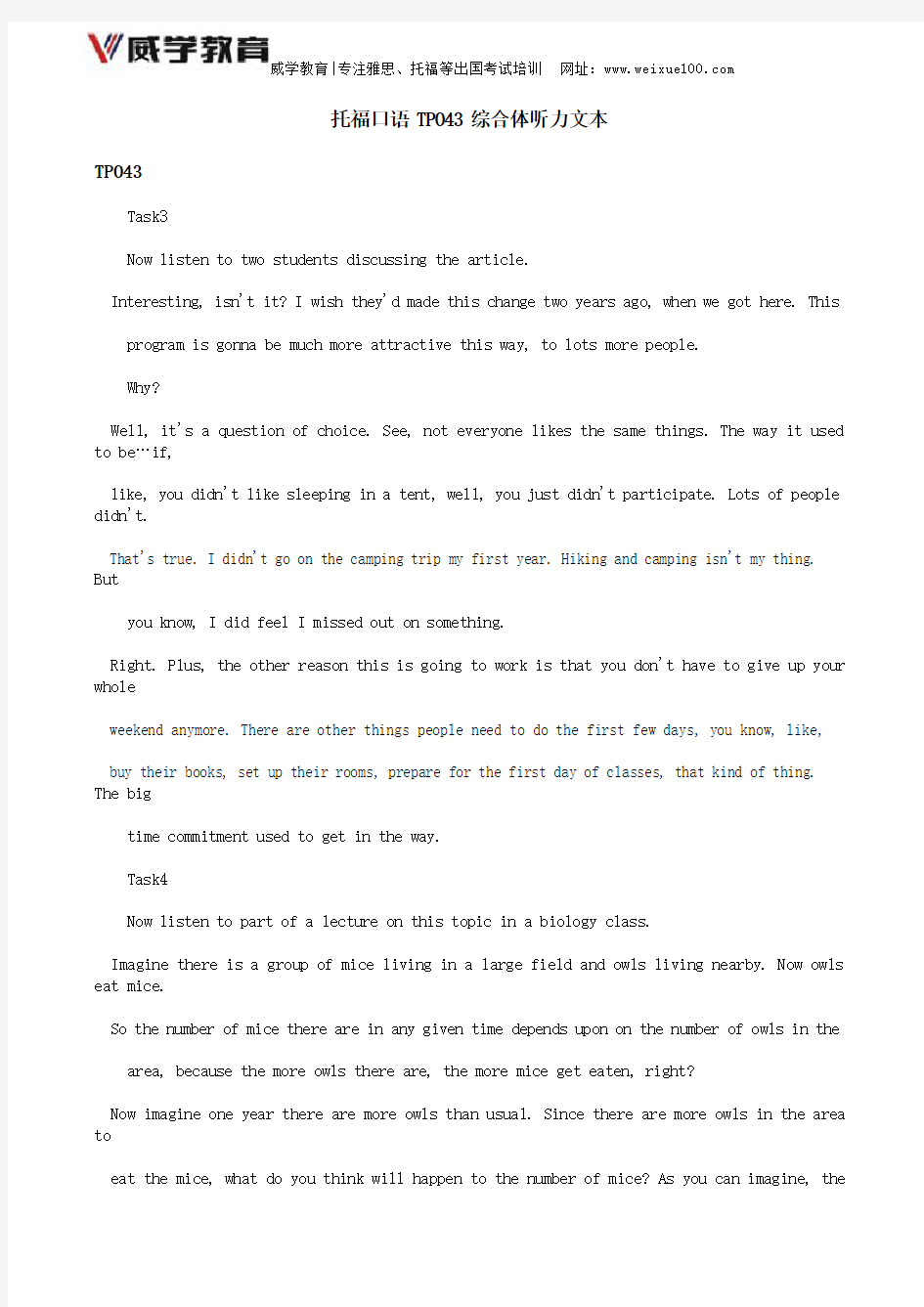【威学教育】托福口语TPO43综合体听力文本


托福口语TPO43综合体听力文本
TPO43
Task3
Now listen to two students discussing the article.
Interesting, isn't it? I wish they'd made this change two years ago, when we got here. This
program is gonna be much more attractive this way, to lots more people.
Why?
Well, it's a question of choice. See, not everyone likes the same things. The way it used to be…if,
like, you didn't like sleeping in a tent, well, you just didn't participate. Lots of people didn't.
That's true. I didn't go on the camping trip my first year. Hiking and camping isn't my thing. But
you know, I did feel I missed out on something.
Right. Plus, the other reason this is going to work is that you don't have to give up your whole
weekend anymore. There are other things people need to do the first few days, you know, like,
buy their books, set up their rooms, prepare for the first day of classes, that kind of thing. The big
time commitment used to get in the way.
Task4
Now listen to part of a lecture on this topic in a biology class.
Imagine there is a group of mice living in a large field and owls living nearby. Now owls eat mice.
So the number of mice there are in any given time depends upon on the number of owls in the
area, because the more owls there are, the more mice get eaten, right?
Now imagine one year there are more owls than usual. Since there are more owls in the area to
eat the mice, what do you think will happen to the number of mice? As you can imagine, the
number would drop. There would be fewer mice.
As far as the other factor, we can use rabbits to help understand this one. Imagine a population
of rabbits living in an area. These rabbits usually start having their young at the end of winter,
after the cold winter weather is gone. And they keep reproducing until the following winter when
they will stop again while the cold winter weather lasts.
But let's say this year the winter season is very short, and you know, it starts getting warm much
earlier than usual. Since winter this year is so short, the rabbits can start reproducing much
earlier. That means the rabbits in that area will have at least one extra reproductive cycle, so of
course one extra litter of baby rabbits. So the number of rabbits in that area would increase a lot.
Task5
Listen to a conversation between the two student editors of a photography magazine called Campus Photo Monthly.
We are in trouble, Barbara. I don't think we can put together next month's issue. There just aren't
enough good photos.
It's getting harder and harder to put together an issue.
Yeah. And this month is the worst ever! I don't get it. I mean, students are submitting lots of
photographs, but I think we've only got fifteen that are worth publishing. And we can't print the
magazine with only fifteen photographs.
Well, maybe we're being too selective. What if we use photos that maybe aren't great, but…
But that aren't horrible?
Right. I mean some of these photographs we get from beginning photographers may not be the
best. But if we lowered our standards just a bit, we'd have a lot more photos to publish.
Sure. But we'd have to be careful. We don't want to get a reputation for publishing low-quality work.
Well...maybe…you know, maybe we are just publishing too frequently. What if we stop publishing
every month and instead, you know, if we just published every two months, we'd have a lot more
submissions to choose from so we could pick and choose and still publish only the good ones.
I guess. But people on campus sort of expect us to publish every month. I mean, we are Campus
Photo Monthly, aren't we?
Task6
Listen to part of a lecture in a biology class.
Okay. So we've been talking about what most animals do when they need food. They simply go out and look for it.
But some animals do something entirely different when they need food. Surprising as it may sound, some animals actually spend a great deal of time taking care of their own food source.
They cultivate it, sort of the way human farmers would. So it will keep growing until it's ready for
them to use.
Let's start with an animal that cultivates plants. There's a certain fish - it's called a damselfish -
that likes to eat a special kind of seaweed. So wherever a patch of this seaweed grows, there will usually be damselfish swimming above and around it. Now the fish are there to provide
protection from other plants so the seaweed can grow and then regrow as the damselfish eat it.
For example, if other plants start growing over the seaweed blocking sunlight. The damselfish
remove those plants by biting off the parts that are getting too tall. So by protecting the seaweed
from being overrun and damaged by other plants, the damselfish always have a supply of food
ready to use.
Now, some animals don't cultivate plants; they take care of other animals as a source of food. Take ants for instance. There are some species of black ants that care for tiny insects called aphids. These aphids produce a sweet liquid that the ants like to eat. So ants guard the aphids from being eaten by other animals and help feed the aphids. In fact, sometimes the ants even
carry aphid eggs back to their own nests and raise the young aphids there. Then the aphids grow
and produce the sweet liquid that the ants eat. So the ants make use of the aphids as a reliable source of food.
